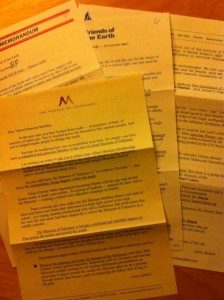 I'm on information overload!
This is a photo of less than two weeks of communications from the elementary school where my daughters go, not including those papers that disappeared into the uncharted nooks and crannies of my 8-year-old's backpack. And it doesn't include e-mails.
I'm on information overload!
This is a photo of less than two weeks of communications from the elementary school where my daughters go, not including those papers that disappeared into the uncharted nooks and crannies of my 8-year-old's backpack. And it doesn't include e-mails.
When you've got this much information coming through the house -- and that doesn't include the mail, newspapers and magazines, emails, Facebook messages, Tweets and texts -- you have to prioritize.
I've developed a system that keeps my head above water. When I get the daily stack, I always manage to find time to look at my kids' drawings, read their paragraphs and listen to the new songs they've learned. That's important to them, and so it's important to me.
Next up are the sheets of paper with obvious deadlines. Anything that says, in great big letters, "Sign this or your kid will be left crying in the cafeteria while the rest of the class skips off to the zoo!" gets my attention.
And that leaves the rest of it. Volunteer opportunities. Plant sales for other classes. The name of the kid who won the spelling bee. The PTA meeting minutes. Upcoming events and festivals.
Most of that third group never even gets read before I recycle it in an effort to find the surface of my dining room table.
So. What does my kids' school's communication issue have to do with your nonprofit? Well, I'm pretty sure my neighborhood school isn't the only group out there throwing everything they can at their constituency, hoping to get a few responses here and there.
The funny thing is, most schools would never communicate with their students this way. Teachers know that if you want kids to act, you have to give them simple, direct instruction, uncluttered by distractions and without too many options. The same is true for your donors.
Your donors have priorities, and for many of them, that does not include reading every word you write for them. (And as a copywriter, I hate to even think that!) Try these tips for more effective donor communication:
Make it easy for them to see what you're asking them to do. Highlight the important text with bold, italics, underline or even by circling specific words and phrases in the copy. Indent ask paragraphs and other copy that summarizes your main point. I keep wishing that the school newsletter was divided into action sections so I could easily see what I need to do.
Use urgency to get them to act. Deadlines work. If you can't put a specific deadline on your campaign, use language that conveys the importance of acting immediately. Highlight these passages to enhance their effectiveness. When papers from school come home with deadlines, I can put them in date order and tackle them as they come up. No date? I guarantee it will get lost to recycling before I deal with it.
Appeal to what you know is important to them, not just what's important for you. To do this, you have to understand a few things about your donors. Why did they give to your organization in the first place? What do they hope to accomplish with their giving? You may have to spin some of your needs to make them appealing to your donors. But keep their interests in mind when you're writing to them if you want them to respond to your communications.
Bonus tip: If you can use segmentation to identify those donors who give to specific campaigns (but not to any other asks), you can focus their mailings specifically on the issues that interest them and personalize their mail to acknowledge their dedication to that issue. I don't have a kid in the fourth grade, so I find it endlessly irritating to receive reminders about the 4th grade talent show. Know your audience and cater to their needs and interests.
Focus for Success. If your idea of a good direct mail package includes a letter about your education program, a planned giving brochure, a petition for an activist effort, and a fridge magnet advertising your annual festival, you can't blame your donors for feeling overwhelmed and confused...and for tossing your package aside. Keep your package simple and focused on one major issue so your donor doesn't have to work so hard to understand just what she's supporting with her gift.
Now, my kids' elementary school doesn't have a communications director. Their primary directive is educating my children, not ensuring I know what's going on. So I cut them some slack.
And I know that many nonprofits can't afford full-time communications directors either. Indeed, you might feel that your main objective is your mission, not making your donors happy. But informed donors are donors who give, year after year. They make your mission possible.
It's in your best interest to engage everyone at your organization in an effort to communicate with them as effectively -- with respect for their time, energy and dedication to your cause -- as you can.
How does your organization minimize communication clutter and maximize giving? Please share your ideas in the comments -- I'd love to hear about them!
 Direct mailer writers always talk about making our mail "personal". For us that means lots of "I, you, we", using a conversational tone, and, quite often, fudging the rules of grammar a bit.
But the other day, a couple of things happened that reminded me that there is another way to keep things personal -- something it's all too easy to forget in this day and age of social media connections and conducting business by e-mail.
Direct mailer writers always talk about making our mail "personal". For us that means lots of "I, you, we", using a conversational tone, and, quite often, fudging the rules of grammar a bit.
But the other day, a couple of things happened that reminded me that there is another way to keep things personal -- something it's all too easy to forget in this day and age of social media connections and conducting business by e-mail.










